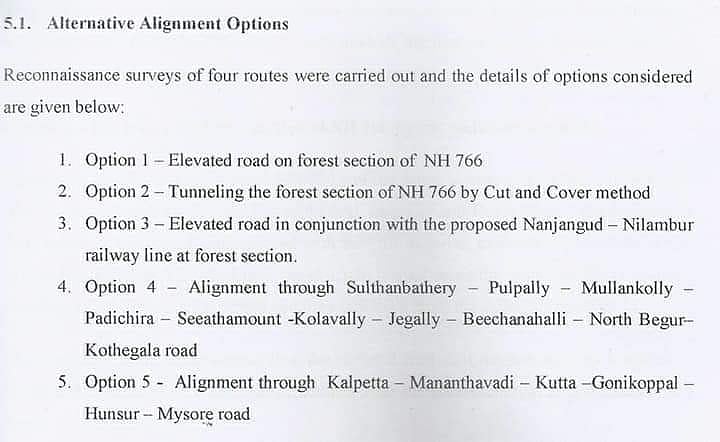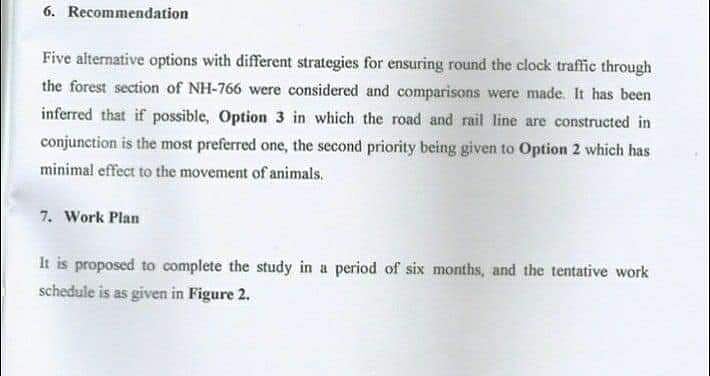Wayanad protest: Kerala govt forgets to suggest in SC route preferred by state report
Instead of NH-766 which is set to be closed, Kerala did not suggest the more favourable Sulthan Bathery-Valluvadi-Mysore route. Activists suggest that it was done to favour routes near Kannur airport

It is increasingly becoming clear that the Kerala government has misled the Supreme Court in the night-traffic ban on NH 766 case which had last come up for hearing on August 7, 2019.
The Supreme Court had suggested that the NH-766 be closed and an alternate Sultan Bathery- Gonikuppa-Mysore route be opened on the advise of the Karnataka. But this route will adversely affect the farmers of Wayanad and that is why protests have reached a crescendo in the district, whose MP is Rahul Gandhi.
The NH-766, which is 272 km, connects Kozhikode in Kerala with Kollegal in Karnataka via Mysore. At least 19.7 km of this highway passes through Bandipur National Park and Wayanad wild life sanctuary. This highway passes through Kalpetta and Sultan Bathery, both of which are in Wayanad district. This route has been proposed to be shut down.
Instead of NH-766 that is proposed to be closed, the Kerala government did not even mention the existence of a “most preferred route” suggested by the National Transportation Planning and Research Centre (NATPAC) in its report to the state government in 2014.
This “preferred route” route begins at Sultan Bathery, passes through Valluvadi in Kerala, then Chickabargi in Karnataka and then touches Mysore (Sultan Bathery- Valluvadi-Chickabargi-Mysore). This route is only 95 km and only 9 km of this route passes through the forest area, of which only 6 km is through the Bandipur Tiger Reserve. This route is the same as the proposed Nilambur-Nanjangud railway line, where both the road and rail line will run beside each other. The proposed railway line will be the shortest route from Thiruvananthapuram to Delhi via Bengaluru.
Even the Wayanad Prakrithi Samrakshana Samiti (WPSS), one of the petitioners on whose behalf the night ban was imposed by the Karnataka High Court in the forest stretch of NH-766, is willing to consider this route. “If this is a much shorter route, this must be considered. We must also look at if there are any animal corridors. The Ministry of Environment and Forests (MoEF) must take a look at this route especially because it is the shortest route,” underscored N Badushah, president of WPSS.
There are three other proposed alternative routes – all of which are not favourable to the people of Wayanad and two of these have been rejected by the Supreme Court.
The first of these routes is the existing Sultan Bathery to Mysore through NH 766, which is 115 km long. This is route through Bandipur National Park where the night-ban exists. The NATPAC report had suggested that an overbridge has to be built to facilitate traffic, but it was rejected by the Supreme Court in its latest order on August 7, 2019. On the route itself, it was suggested that a tunnel be built, but it has no takers due to risks and higher costs involved.
The other route on the list was Sultan Bathery-Beechanahalli-Mysore route, which goes through 17 km forest area. But, this route is no longer being recommended or considered as there is no existing road on most parts of the route.
The next route is the Sultan Bathery-Gonikuppa-Mysore route. This passes through Nagarhole Tiger Reserve, Wayanad Wildlife Sanctuary, Rajiv Gandhi National Park. Of this 200 km route, 25 km goes through the wildlife sanctuary areas. This is the route that has been suggested as the alternative now.
This route passes through the ecological fragile area in Coorg (Kodagu). Hence, farmers, environmentalists in both Karnataka and Kerala are against this route.
What is surprising is that the forest department did not mention that this route goes through ecological sensitive and forest areas. The Supreme Court in its latest order on August 7, 2019, had suggested that this route must be brought to National Highway standards.
“The width of the road on this route is less than 10 mt. For this road to be made to NH standards, it will have to be widened to 45 metres. For this, almost 240 acres (95 hectare) of forest land has to be acquired. This goes beside the bird sanctuary Pakshi Pathalam, which was hailed by Salim Ali for its rich diversity,” explained Abdul Razakh, the executive member of the Nigiri-Wayanad NH and Railway Action Committee.
For this route to be sanctioned, 1,400 acre of ecologically fragile farmland has to be acquired and compensation given. Moreover, several thousands of trees will have to be cut down. In all likelihood, this will run into severe opposition and protests.
Ironically, the most troublesome route was the only one suggested by Karnataka government in the Supreme Court and agreed to by the Kerala government. The only other route suggested by Kerala was the Thallassery-Mysore railway line.
“The suggestion of Sultan Bathery- Gonikuppa-Mysore route as the alternative and possible closure of NH-766 was the immediate trigger for the current protests. People in Wayanad are against this alternate route because farmers from Wayanad have to travel an excess of 200 km to reach Gundalpet, which is where they have taken up land on lease for cultivation. It is these farmers, especially the ginger farmers, who sustain the economy of Wayanad. Almost 4,000 daily-wage labourers come from Gundalpet and surrounding areas using the NH-766 to Wayanad to work on construction sites and estates,” explained Razakh. Currently six buses (three from Kerala Transport and three Karnataka Transport) operate 18 trips per day between Gundalpet and Sultan Bathery.
Even the Wayanad Chamber of Commerce (WCC) is in favour of the Sultan Bathery- Valluvadi-Chickabargi-Mysore route. “We are in favour of the existing NH-766 being functional. But, if that has to be closed, then we are in favour of the Valluvadi route suggested by NATPAC report as that is the shortest route for farmers. In fact, this runs almost parallel to NH-766 and reduces the distance for farmers and travellers from Sultan Bathery by almost 20 km,” highlighted Johnny Patani, WCC president.
Kerala government’s willful omission
The factor linking the non-disclosure of the “most preferred route” and the acceptance of the most inconvenient route to the people of Wayanad is the Kannur International Airport, in which the Chief Minister Pinarayi Vijayan has taken particular interest.
The CM has been traveling to the Capital to meet Nitin Gadkari, minister for roads and transport, quite often to ensure the development of six roads to the airport into four-lane highways. One of these six routes is the ‘Koottupuzha Bridge-Iritty-Mattannur-Vayanthode Road’. This road comes joins the ‘Sultan Bathery- Gonikuppa-Mysore route’ at Gonikuppa. This ensures a four-lane route to Kannur airport, which currently does not have many flights, and several are expensive.
Within 300 km radius of the Kannur airport, there are four other airports – Kozhikode International Airport, Mysore Airport, Kempegowda International Airport Bengaluru and Mangalore International airport. All of these airports are seen as hampering the growth of Kannur airport, especially the Kozhikode airport.
Mysore airport has a 900 mt runway and only UDAN flights currently operate from this airport. The second phase of expansion includes building an overhead runway and Indian Air Force will be aiding it. After this, international flights are likely to be scheduled.
Currently, people from Wayanad and Coorg travelling abroad use the Bengaluru airport and if Mysore airport is developed, people are likely to use it more than the Kannur airport is what several activists claim. As the functioning of the Mysore airport works against the profitability of the Kannur airport in the long-term, the Kerala government is allegedly looking for ways to block direct access to Mysore.
Rail routes through Wayanad
In the Supreme Court, Kerala government had requested for a Thallassery-Mysore railway line instead of the existing NH-766 road as their first preference. This railway line will be of no use to the people who will be affected by the closure of NH-766. This proposed Railway line goes through the CM’s constituency and in front of the Kannur airport.
The second route requested by the Kerala government, instead of NH-766, is the Sultan Bathery- Gonikuppa-Mysore route.
If the Sultan Bathery-Valluvadi-Chickabargi-Mysore had gotten approved, it would have improved connectivity to both Mysore and Bengaluru airports. “We can reach Mysore airport in 1.5 hours on a bus through this route and even lesser on a car from Sultan Bathery. If we have to go to Kannur Airport, it will take us three hours. From Mysore to Bengaluru, there are frequent buses and it costs only Rs 700. This government does not think of the common man,” explained Razakh.
Wayanad has no railway track through it, but the Delhi Metro Rail Corporation (DMRC) survey had suggested that the Nanjangud-Sultan Bathery-Nilambur Railway line was feasible. In fact, work on it had even begun by DMRC in 2016 under the supervision of E Sreedharan, known by the moniker metro man. The government had sanctioned Rs 2 crore for it too, but the amount was not released.
In 2017, Sreedharan withdrew the project as the Pinarayi Vijayan government was not keen on this route, instead had insisted that the Thalassery-Mysore route be considered. This was despite the feasibility study done for this route by DMRC finding this railway line to be grossly un-remunerative as the project cost was estimated to be Rs 7,000 crore. The per km cost of the project worked out to be Rs 32 crore. DMRC had said that this line would be “beneficial only to the people of north Malabar and for the rest of Kerala the existing route will continue to be convenient”. So, traffic on this line was expected to be low.
However, despite this suggestion of unviability, this route (Thallassery-Mysore railway line) was Kerala government’s first option.
The series of protests in Kerala have seen people from all walks of life join it as the blanket ban of traffic through NH-766 would impact Wayanad economically. The case is set to be heard again on October 18 in the Supreme Court.
Follow us on: Facebook, Twitter, Google News, Instagram
Join our official telegram channel (@nationalherald) and stay updated with the latest headlines
Published: 06 Oct 2019, 12:30 PM


